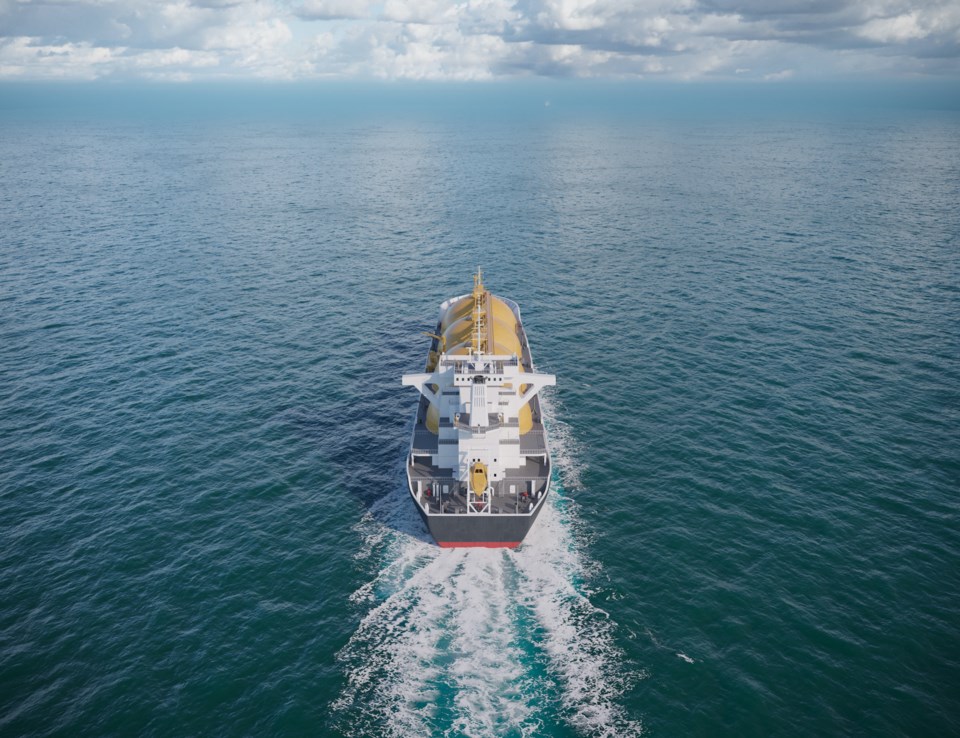On Nov. 24, the Institute for Energy Economics and Financial Analysis published a study called .
"Market and non-market shifts have severely tested LNG Canada's long-term economic viability and could turn it into a financial albatross for its sponsors," reads the study.
"The fallout would jeopardize proposed major LNG projects along Canada's western coast, including , Woodfibre LNG, and ."
In one scenario, the study predicts that LNG Canada could be losing $0.41 for every one million British thermal units, or MMBtu, towards 2030. This would account for a loss of 15.5%.
That prediction was based on comparing the costs of the massive project — which include the construction of the Coast GasLink pipeline — with the projected prices and costs of doing business.
The numbers in that forecast, while sobering for LNG projects in general, may not apply in the same way to Woodfibre, which is of a much smaller scale than LNG Canada.
"I think that the size of Woodfibre works for [it] and against [it]. Two million tonnes is certainly easier to sell into the market and gives you the critical mass to move the project ahead," said Brad Williams, co-author of the paper.
"The challenge is, for the smaller project, is less [gas] to spread the costs over. But [I] would think that being two million tonnes would give you [a] real market opportunity. My perspective — the cost of the gas supply coming from Fortis is going to be higher."
The bottom line is that Woodfibre faces both an advantage and a risk as a result of its scale, he said.
"I think that Woodfibre has less market risk, because you're not building a $6-billion pipeline, but your cost of fuel is going to be higher coming through Enbridge and through [Fortis]," said Williams.
"But it does give you supply security, because if you're buying gas from the [supplier] they'll have a supply obligation, whereas LNG Canada, they have to acquire either their own production or buy it from others and they pay Trans Canada to move through that 600-kilometre pipeline."
The cost of the facility and the smaller hurdles to overcome are advantages for Woodfibre over a big project like LNG Canada, he said. However, the challenge facing the Squamish project is the cost of gas.
Omar Mawji, the other co-author of the paper, said that there are also cost risks associated with the political response to the project.
"There's likely going to be pushback on a facility like that, and that aspect of it, the potential for cost increases associated with that pushback, hasn't been factored in.
"There's no estimate of what that cost could be, but it's a huge risk for Woodfibre."
In response to the report, local activists painted a bleak future for LNG.
"LNG has gone from boom to bust. These new fossil fuel infrastructure projects are not economically viable, and cannot survive without massive government subsidies and tax breaks," said Tracey Saxby of in an email to The Chief."The 小蓝视频 NDP government has committed at least $5.35 billion in public handouts to LNG Canada, and other fossil fuel subsidies have doubled since Premier Horgan took office to $1.3 billion in the last year alone (2020/2021). If we can't make money exporting 小蓝视频 LNG, why are we losing money to subsidize these climate-wrecking projects?"
Saxby added that "British Columbians have been hit with the worst climate catastrophe in 小蓝视频’s history.""Thousands of people have been displaced from their homes, and landslides have shut down highways and isolated communities," she wrote.
"Quite frankly, I'm scared. We are experiencing the impacts of climate change, right now. This is only 1.2 degrees of warming — what the hell will 1.5 degrees look like? Or 2 degrees?"She noted thethat natural gas demand will increase until 2025, but from there on it will remain flat until 2050.
The agency called on world governments to immediately stop investments in and approvals of oil and gas projects to ensure we limit warming to 1.5°C and achieve net-zero emissions by 2050.
"We need to redirect precious public money to provide flood relief for British Columbians, repair highways, and commit to urgent, emergency-level climate action," Saxby wrote."We need an immediate moratorium on the development of new fossil fuel infrastructure like Coastal GasLink, LNG Canada, and Woodfibre LNG. If it's not built yet, it should never be built."
Regarding subsidies from the provincial government, Williams said the benefits that Woodfibre is getting aren't unusual compared with other projects he's seen."The tax credits are very typical for any major large economic infrastructure investment. So it's nothing unusual that the provincial or local governments provide some tax incentives to attract a project. And, in the U.S., that's very typical for LNG projects or chemical plants or anything like that," he said.
"So there's nothing unusual that I see with Woodfibre that's atypical. It's not like you're getting some windfall benefit that other projects don't get also."
In response to the study, Woodfibre spokesperson Rebecca Scott issued a written statement to The Chief.
"Multi-billion dollar projects are complex and challenging. Recognizing this reality, Woodfibre has been taking the time early on to design a next-generation facility that will lead the global energy transition," wrote Scott.
"Our project shows that not all LNG is created equal. As the world moves toward cleaner energy, demand is rising for low-emission supply. With an emissions intensity 10 [times] below average, Woodfibre will be the world's cleanest LNG facility. While the project serves as a model for future sustainable natural gas export, it is unlikely that other facilities will be able to reduce emissions to our level."
She said the project has sold over 70% of its future through-put and company officials are very optimistic about Woodfibre's long-term viability.
***Nov. 30, 9:40 a.m.: Please note this story has been corrected to more accurately reflect statements from Tracey Saxby.




